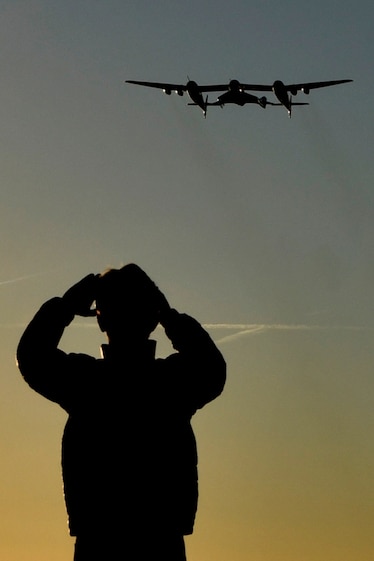Virgin Galactic’s third commercial spaceflight has taken to the skies—but it wasn’t just carrying a cargo of wealthy investors in search of a taste of microgravity. Two very different passengers were on board too: the fossils of ancient human ancestors discovered in the cradle of humankind.
In tribute to humanity’s longstanding thirst for exploration, fossilized bones from two ancient species, Australopithecus sediba and Homo naledi, hurtled into suborbit on Virgin Galactic’s spacecraft, V.S.S. Unity. They journeyed alongside three private astronauts, along with two pilots and one astronaut instructor, who were pushed to the edge of space with a rocket that briefly thrust them into microgravity and to an apogee of about 300,000 feet above Earth’s surface before returning to the launch site in Truth or Consequences, New Mexico.
(The future of spaceflight—from orbital vacations to humans on Mars.)
It was the first time the fossil of a human ancestor has been to space. But why send fossils into space at all? Entrepreneur and philanthropist Timothy Nash, who carried the fossils in his pocket during the flight, tells National Geographic it offers a change to reflect on the enterprising spirit of our earliest ancestors.
“These early species and near relatives were really all on a journey of discovery and exploration as they evolved, moved out of the environment they were in, and slowly began to populate the world.”
Early human ancestors
Both hominin species are relatively new additions to the scientific record. Lee Berger, a paleoanthropologist and National Geographic Explorer in Residence, has been central to research on both species: His son Matthew discovered the fossilized clavicle of Australopithecus sediba in South Africa in 2008, while Berger and a team of “underground astronauts” discovered Homo naledi in another South African cave in 2013.
Though both species are classified as hominins, a zoological “tribe” of which only Homo sapiens survives today, debates still rage on their abilities, their lives, and their position on our family tree.
While Berger and his colleagues posit that Australopithecus sediba may be a direct human ancestor, other scientists believe that’s unlikely due to the timing of the species’ existence and its morphology. Australopithecus sediba lived about 1.98 million years ago—800,000 years after the earliest known Homo sapiens.
Homo naledi is closer to humans on the family tree, estimated to be between 236,000 and 335,000 years old. Berger and his team say the evidence suggests Homo naledi engaged in human-like activities such as burying their dead and creating art, a precursor to modern human innovation.
(This mysterious human species may have been the first to bury their dead.)
“These species were part of the contribution to what many consider the greatest human accomplishment of all time—[going to] space,” Berger says.
But the abilities of early hominins remain hotly debated, too, and questions remain about how humans developed from small-brained, primate-like creatures into their modern form. Still, Berger says the decision to launch these specimens into suborbit is a way of honoring the deep roots of science and innovation, which “are almost always in Africa, from the invention of fire to the creation of symbols and art and making meaning.”
A long journey to space
Questions about humanity’s roots have long intrigued Nash, who has a longstanding interest in human evolution. Long before the billionaire became a space tourist, he purchased a large swath of land in South Africa known as the Cradle of Humankind. Home to the world’s largest concentration of human ancestral remains—including the cave where Australopithecus sediba was eventually found—this land has been a UNESCO World Heritage site since 1999.
(Puzzling skeleton helps reveal how early human relative grew up.)
Nash purchased the land to create a private nature preserve and says he’s so committed to protecting the sites where humans’ earliest ancestors lie that he has a tattoo of “Karabo,” the boy whose clavicle he’ll carry to space, on his shoulder.
He has another tattoo too: the Virgin Galactic logo. Nash was among the first hundred investors in the company, and patiently waited his turn to breach the atmosphere in an hour-long commercial spaceflight taking him, and the fossils, to Mach 3 speed and suborbital space.
For Nash, the thought of viewing both Earth and the blackness of space has prompted reflections on how far humanity has come. “I think it’s going to be the experience of a lifetime,” he told National Geographic before the journey. As for the danger of taking one-of-a-kind fossils to suborbit with commercial spaceflight still in its infancy, he says it’s worth the risk. “These are only a very small part of the fossil record, and they have been very well studied. Exploring involves risks. Human advancement requires risks.”
Still, just to be safe, he planned to transport the fossils in a carbon fiber tube that Berger would watch over until a ceremony shortly after takeoff.
“They are two of the best studied, best replicated things in our collections,” says Berger, who cites the abundant documentation of the fossils as one reason they were selected for the spaceflight.
Another is their resonance. Berger says he selected the Australopithecus sediba clavicle because it is the one Berger’s then-9-year-old son discovered, uncovering a previously unknown hominid species. “I want kids to know there are things you can discover and that children can contribute enormously,” he says.
The inclusion of a Homo naledi thumb bone, likely from a female, is also “particularly poignant,” says Berger. “They may have been carving deep meaning-making symbols on that cave wall, making fire, burying the dead,” he says. “Going into dangerous places, caring for you loved ones, symbols, wondering about our own mortality, the creation of fire—these are all the things necessary to build a spaceship.”
